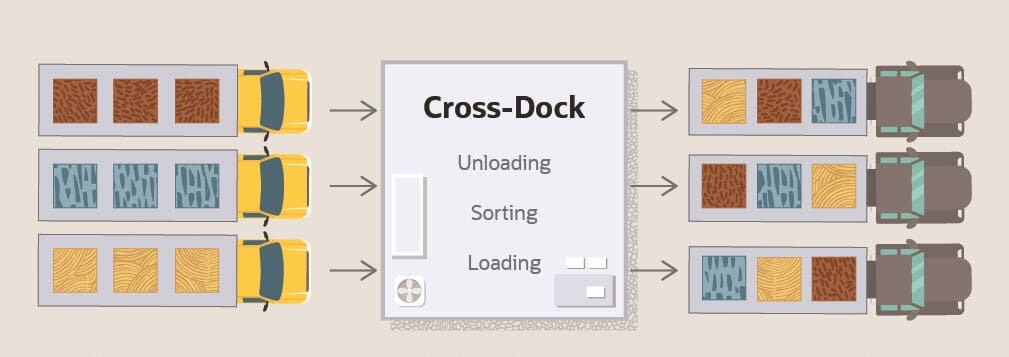Have you ever thought during your inventory management day, “Man, I think I could take the products off the truck in receiving and send them straight out on the shipping side?” Well, many people have and do. This practice is called cross-docking, and there are several ways to implement it.
Cross-docking is a strategy especially popular for time-sensitive industries or industries with perishable goods. Having little to no storage time is perfect for those types of industries and could also be a good fit for your organization. In this article, we will discuss cross-docking, along with examples and a general step-by-step guide. After that, it’s up to you to find industry-specific strategies that fit your business. But don’t worry – there are some common practices that you can learn from and mimic, so you don’t have to reinvent the wheel.
A Cross-Docking Example
Let’s start with a quick example to paint the picture properly. Imagine that you own a grocery store chain. You have fresh fruits, dairy products, and canned goods that arrive daily from different suppliers at the central distribution center. But you have been having some storage issues. Your aim is to get the products to your individual retail stores quickly and efficiently, and after learning about cross-docking, you know that strategy will get you there.
As the delivery trucks roll in, the items are sorted quickly, grouped by their respective categories, and, without delay, transferred to waiting outbound trucks. You tell your team to consolidate products destined for specific stores. Once loaded up, the trucks make their way to your individual stores across the city. Now, the fresh produce stays crisp and dairy products remain cool. You have helped minimize storage time, lower inventory costs, keep the shelves stocked with various products, and improve customer experience.

What Is Cross-Docking? Definition, Types & Advantages, Abby Jenkins for NetSuite
Implementing Cross-Docking with the Consolidation Method
Now, let’s learn about the three phases of implementation for the consolidation method of cross-docking.
1. Receiving and Sorting
The first phase is receiving and sorting. The inbound shipment from the various suppliers will arrive at the central distribution center. You must sort the products based on their intended destination. This process could involve breaking down pallets and grouping the products for specific store orders. It is the most time-consuming part of the process and should involve a lot of coordination and communication. A smooth single-touch process should be adopted here.
2. Transfer and Consolidate
The second phase is to transfer and consolidate. Products sorted are then moved directly from the receiving docks to the outbound loading docks without being placed in long-term storage. The products arrive at the outbound docks and are matched with the corresponding store orders. Some people like to use floor markers or hang signs over the staging areas. Then, you’ll consolidate the products where items intended for the same store are grouped.
3. Outbound Shipping
The last phase is all about the outbound shipping. Once all the required products for a certain store order have been grouped and gathered at the outbound dock, they are loaded onto the delivery trucks specified just for that store. Trucks leave the distribution center as soon as they are fully loaded, which minimizes storage and time. The trucks make their deliveries directly to the retail stores, reducing transportation time and costs. It’s a simple win-win process.
Multiple Methods for Cross-Docking Success
There are many ways to implement the cross-docking technique. There is the flow-through method, an immediate transfer, the consolidation method we just learned, and the deconsolidation method, which breaks larger shipments into smaller ones. These are the most popular cross-docking methods and usually fit most situations.
There are warehouse management systems, transportation management systems, and real-time tracking and monitoring solutions that can help you optimize this cross-docking process and provide visibility and control of your inventory and shipments. Explore these options and decide which product is right for you and your business.
Is Cross-Docking Right for Your Business?
To see if cross-docking is appropriate for your business, you should thoroughly analyze your supply chain, product characteristics, and demand patterns. Cross-docking is most effective for products with high turnover rates, stable demand, and products that don’t require long-term storage. As previously stated, perishable goods and fast-moving consumer goods are ideal candidates for cross-docking.
Several challenges can arise when implementing cross-docking. There is a distinct need to be precise in coordination, timing, and organization. Your team must be able to manage large volumes of incoming and outgoing shipments; you must be mindful of product quality and accuracy; you must also be able to handle potential disruptions in the supply chain. Having your forecasting systems operational and predicting demand shifts or supply chain issues is paramount to ensuring that your transition to cross-docking is smooth and fruitful.
While it can be challenging to implement cross-docking depending on your industry, the practice may benefit your business’s bottom line. It includes reduced storage costs, faster order fulfillment, lower inventory holding costs, improved supply chain efficiency, and reduced product obsolescence risk. Quick, smooth processes almost always mean cost savings.
Train Your Team and Expect Success
When you’re ready to implement cross-docking, it is key to make the process simple and easy for your employees to understand. Implementing strict quality controls and labeling procedures, using technology such as barcode scanners, and training employees adequately to minimize errors are all critical for cross-docking success.



